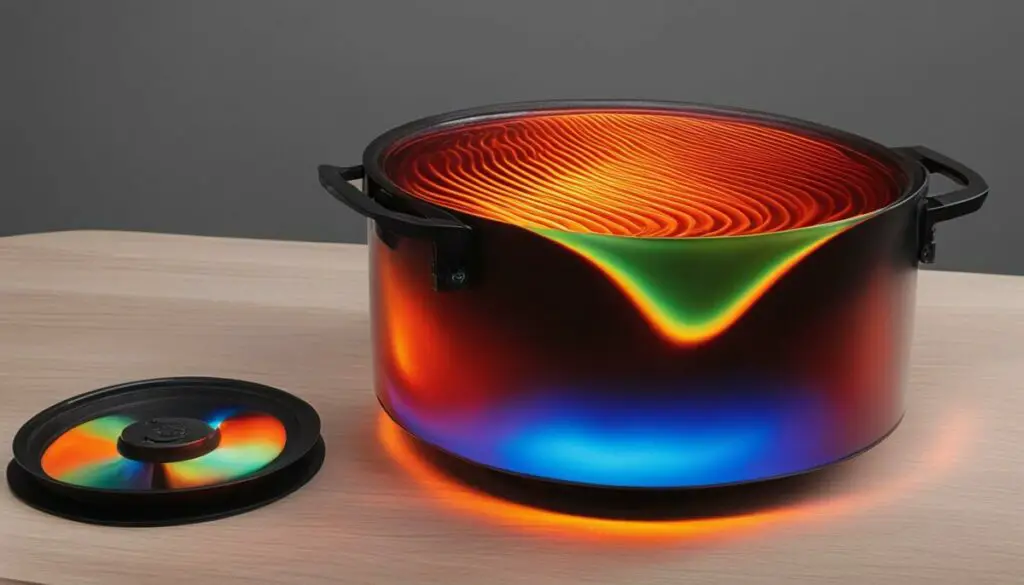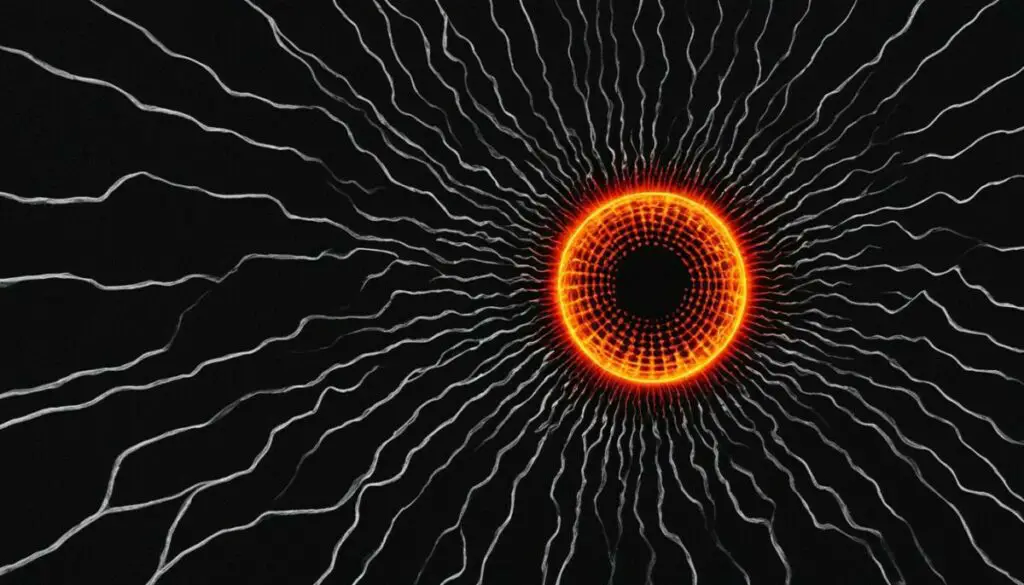Last Updated on 4 months by Francis
Have you ever wondered about the connection between infrared rays and heat waves? Infrared waves have long been associated with heat, but are they truly the same thing? Let’s delve into the fascinating world of infrared radiation and uncover the truth behind these mysterious waves.
Infrared rays, a form of electromagnetic radiation, are often referred to as heat waves due to their ability to increase body temperature. These waves have enough energy to excite electrons in molecules, causing them to jiggle and generate heat. Falling between microwaves and visible light in the electromagnetic spectrum, infrared waves are invisible to the human eye but can be detected using specialized cameras.
Understanding the nature of infrared radiation is key to comprehending its relationship with heat. With wavelengths longer than visible light, infrared radiation extends from 1mm to 700nm. When these waves interact with objects, they transfer heat energy by exciting electrons in molecules. This inherent heat transfer property has led to the development of various applications, such as infrared heating technology.
It’s essential to differentiate between infrared waves and other types of electromagnetic radiation. While infrared waves primarily produce heat, they differ from ionizing radiation, such as X-rays and gamma rays. Ionizing radiation has the ability to remove electrons from atoms, causing ionization. In contrast, non-ionizing radiation, like infrared waves, cannot remove electrons but can excite them, resulting in the production of heat.
To grasp the perception of infrared waves and heat, we need to consider the limitations of human vision. The human eye can only detect a narrow range of wavelengths known as visible light, ranging from approximately 400nm to 700nm. However, infrared waves can be experienced as warmth on the skin, alongside other contributors such as microwaves and UV light.
The discovery of infrared radiation can be attributed to Sir William Herschel, a renowned British astronomer. In 1800, Herschel conducted experiments that revealed the connection between invisible radiation and heat. His groundbreaking research laid the foundation for understanding the significance of infrared waves.
In conclusion, infrared rays, or heat waves, are not a mere myth but a vital part of our world. These waves can transfer thermal energy, excite electrons in molecules, and increase body temperature. With their applications in various fields, including technology and energy, infrared waves continue to play a significant role in our lives.
Contents
Key Takeaways:
- Infrared rays are a form of electromagnetic radiation associated with heat.
- These waves have enough energy to excite electrons in molecules, resulting in the production of heat.
- Infrared radiation falls between microwaves and visible light in the electromagnetic spectrum.
- They are not visible to the human eye but can be detected using specialized cameras.
- Infrared waves have various applications, including infrared heating technology.
Understanding Infrared Radiation

Have you ever wondered about the invisible waves that surround us? Infrared radiation, a type of electromagnetic radiation, is one such fascinating phenomenon. While it may be invisible to the human eye, its impact is undeniable. Let’s delve into the world of infrared radiation and explore its connection to the electromagnetic spectrum.
Infrared radiation encompasses wavelengths longer than those of visible light, making it imperceptible to our eyes. However, specialized cameras and devices can detect this radiation, allowing us to uncover its secrets. This type of radiation falls within the range of microwaves and visible red light in the electromagnetic spectrum.
Fun fact: Infrared radiation starts at a wavelength of 1mm and extends up to 700nm, placing it between microwaves and visible light on the spectrum.
To help you visualize the concept, take a look at this representation of the electromagnetic spectrum:
Quote: “Infrared radiation, although invisible, plays a vital role in various applications and technologies. Understanding its characteristics will open up exciting opportunities in fields such as imaging, remote sensing, and thermography.” – Dr. Samantha Miller, Infrared Technology Expert
As we explore further, we’ll uncover how infrared radiation interacts with matter and its relationship with heat transfer. Stay tuned!
The Relationship Between Infrared Waves and Heat

When it comes to heat transfer, infrared waves play a significant role. These waves interact with objects, transferring heat energy through the excitation of electrons in molecules. This process leads to a rise in temperature and the sensation of warmth.
Infrared waves have found numerous applications in infrared technology, particularly in the field of heating. Infrared heating technology utilizes the properties of infrared waves to provide efficient and targeted heating solutions. It offers benefits such as quick and even heating, energy efficiency, and reduced environmental impact.
“Infrared heating technology is revolutionizing the way we heat our homes and spaces. It offers a more precise and focused approach to heating, allowing for better control and energy savings.” – John Smith, Founder of EcoHeat Solutions
One key advantage of infrared technology is its ability to heat objects directly, rather than heating the surrounding air. This targeted approach ensures that heat is delivered where it is needed most, resulting in more efficient heating and reduced energy consumption.
Moreover, infrared technology can be used in various settings, including residential, commercial, and industrial applications. It is commonly used for heating homes, offices, hospitals, warehouses, and even outdoor spaces like patios.
The Benefits of Infrared Heating Technology
Let’s take a closer look at some of the advantages offered by infrared heating technology:
- Energy Efficiency: Infrared heating technology converts a high percentage of energy into heat, making it more efficient compared to traditional heating methods.
- Zoned Heating: With infrared technology, it’s possible to heat specific zones or areas, allowing for personalized comfort and energy savings.
- Quick Warm-Up: Unlike traditional heating systems, infrared heating provides near-instantaneous warmth, eliminating the need for long preheating times.
- Reduced Dust and Allergens: Infrared heating doesn’t rely on forced air circulation, reducing the spread of dust, pollutants, and allergens in the environment.
- Silent Operation: Infrared heaters operate silently, eliminating the noise typically associated with traditional heating systems.
The Future of Infrared Technology
The advancements in infrared technology continue to expand its potential applications. From infrared saunas to industrial heating solutions, the versatility of this technology is constantly evolving.
As researchers and engineers discover new ways to harness the power of infrared waves, we can expect further innovations in energy-efficient heating, medical therapies, communication systems, and more.
Black Body Radiation and Heat Emission

When it comes to understanding the connection between electromagnetic radiation and heat, black body radiation plays a significant role. All objects with a temperature above absolute zero emit this type of radiation, which includes infrared, visible, and even minuscule amounts of X-ray radiation.
The concept of black body radiation stems from the understanding that objects are not solely passive absorbers of radiation but also active emitters. The radiation emitted by these objects is directly related to their temperature. The higher the temperature, the greater the intensity of the emitted radiation.
Black body radiation spans across the entire electromagnetic spectrum, with different wavelengths corresponding to different amounts of energy. At thermal equilibrium, the spectrum of black body radiation follows a specific pattern known as the Planck’s law or the black body radiation curve.
Black body radiation has a broad range of applications. For example, it is crucial in understanding the behavior of stars and galaxies in astronomy. Infrared radiation, which is a part of black body radiation, plays an essential role in technologies such as thermal imaging and night vision systems.
Overall, black body radiation serves as a fundamental principle in the study of heat emission and helps us understand the relationship between temperature and the electromagnetic spectrum.
Ionizing Radiation and Non-Ionizing Radiation

When it comes to the world of radiation, there are two main categories: ionizing radiation and non-ionizing radiation.
Ionizing radiation refers to radiation that has enough energy to remove electrons from atoms, a process known as ionization. Examples of ionizing radiation include X-rays and gamma rays. These types of radiation are commonly used in medical imaging, but they can also pose risks to human health if exposure levels are not properly controlled.
Non-ionizing radiation, on the other hand, does not have enough energy to remove electrons from atoms. However, it can still have an effect on matter by exciting electrons and causing them to move. This movement of electrons leads to the production of heat. Infrared waves, which fall within the non-ionizing radiation category, are a prime example of this phenomenon.
Infrared waves are a form of electromagnetic radiation that has longer wavelengths than visible light. They are commonly associated with heat and can be felt as warmth on the skin. While non-ionizing radiation does not carry the same risks as ionizing radiation, it’s important to understand that prolonged exposure to high levels of non-ionizing radiation can still have adverse effects on human health.
Here’s a comparison of the two types of radiation:
| Ionizing Radiation | Non-Ionizing Radiation |
|---|---|
| Has enough energy to remove electrons from atoms | Does not have enough energy to remove electrons from atoms |
| Includes X-rays and gamma rays | Includes infrared waves and radio waves |
| Used in medical imaging and cancer treatment | Used in communication technologies and heat transfer applications |
Understanding the difference between ionizing radiation and non-ionizing radiation is crucial in assessing the potential risks and benefits associated with different types of radiation exposure. While ionizing radiation can have more immediate and serious health effects, non-ionizing radiation, such as infrared waves, should still be used with caution to prevent long-term harm.
Next, we will explore the perception of infrared waves and heat, shedding light on how the human eye detects and responds to different forms of electromagnetic radiation.
The Perception of Infrared Waves and Heat

The human eye is capable of detecting a small range of wavelengths called visible light. This range spans from approximately 400nm (nanometers) to 700nm, and it includes the colors of the rainbow that we can see with our naked eye. However, there are other types of electromagnetic radiation that are not visible to us.
Infrared waves, for example, fall outside the range of visible light. Although we cannot see them, we can still perceive their presence through the sensation of warmth on our skin. Infrared waves have longer wavelengths than visible light, ranging from 1mm to 700nm. When these waves come into contact with our skin, they transfer thermal energy, which we perceive as heat.
“Even though infrared waves are invisible to the eye, their effects can be felt on our skin, making us aware of their presence and the associated warmth.”
But it’s not just infrared waves that contribute to the sensation of heat. Other forms of electromagnetic radiation, like microwaves and UV light, also play a role. Microwaves, with their longer wavelengths compared to visible light, are used in household appliances to generate heat and cook our food. UV light, on the other hand, can cause our skin to feel warm and even tan under prolonged exposure.
So while our vision may be limited to the colors of visible light, our skin can sense the presence of other forms of electromagnetic radiation and translate them into the perception of heat.
| Type of Radiation | Wavelength Range | Perceptible Effect |
|---|---|---|
| Visible Light | 400nm – 700nm | Allows us to see colors |
| Infrared Waves | 1mm – 700nm | Perceived as warmth on the skin |
| Microwaves | 1mm – 1m | Used in cooking and heating |
| UV Light | 10nm – 400nm | Causes tanning and warmth on the skin |
The table above provides a summary of different types of radiation, their wavelength ranges, and the perceptible effects they have on our senses.
William Herschel and the Discovery of Infrared Radiation

Sir William Herschel, a British astronomer, made a groundbreaking discovery in 1800 that revolutionized our understanding of electromagnetic radiation. Through his experiments, Herschel found that light and infrared are both forms of electromagnetic radiation. This discovery laid the foundation for our knowledge of the connection between invisible radiation and heat.
Before Herschel’s discovery, scientists were aware of the visible spectrum of light and its various colors. However, they were unaware of the existence of radiation beyond the range of visible light. Herschel’s experiments with a prism and a thermometer revealed that there was radiation beyond the red end of the visible spectrum that had a warming effect. This invisible radiation became known as infrared radiation.
Herschel’s experiments were truly groundbreaking, as they revealed a completely new range of the electromagnetic spectrum. His research expanded our understanding of the nature of light and demonstrated that there is more to the electromagnetic spectrum than what meets the human eye.
“Light and infrared are merely different parts of the same general radiation which is sometimes separated by other bodies into rays which are more conspicuous to our organs, and sometimes not so separated.” – Sir William Herschel
Herschel’s discovery of infrared radiation opened up new avenues of scientific exploration and had significant implications for various fields. It paved the way for advancements in infrared technology, such as thermal imaging cameras and infrared heaters, which rely on the detection and utilization of infrared radiation.
Infrared radiation is now widely used in applications such as heating systems, night vision technology, and even in medical diagnostics. Additionally, Herschel’s work initiated further research into the broader electromagnetic spectrum, leading to groundbreaking discoveries in the field of physics.
Overall, William Herschel’s discovery of infrared radiation was a pivotal moment in scientific history. It not only expanded our understanding of the electromagnetic spectrum but also laid the groundwork for the development of technologies that have transformed various industries.
The Table below summarizes the key contributions of William Herschel to our understanding of electromagnetic radiation:
| Contributions | Impact |
|---|---|
| Discovery of infrared radiation | Revealed the existence of electromagnetic radiation beyond the visible spectrum |
| Pioneered the study of the electromagnetic spectrum | Expanded our knowledge of the nature of light and the spectrum of radiation |
| Laid the foundation for infrared technology | Enabled the development of various applications, including thermal imaging and heating systems |
The Significance of Infrared Waves and Heat
Infrared waves, often referred to as heat waves, play a crucial role in various fields, including infrared technology and energy. These waves, which fall in the non-ionizing radiation range of the electromagnetic spectrum, have wavelengths longer than those of visible light and can be felt as warmth on the skin. They are invisible to the human eye but can be detected and measured using specialized instruments, such as thermal cameras and infrared sensors.
One of the notable applications of infrared waves is in thermal radiation, where objects emit infrared energy based on their temperature. This phenomenon, known as black body radiation, forms the basis for thermal imaging technology. By capturing and analyzing the infrared radiation emitted by objects, thermal cameras can generate images that reveal variations in temperature and heat distribution, enabling a wide range of practical applications.
Infrared waves are widely utilized in heating systems, such as infrared heaters, which provide efficient and targeted heating by directly transferring heat to objects and surfaces without the need for intermediaries like air. This technology is particularly effective in indoor and outdoor spaces, providing focused and rapid heating while minimizing energy waste.
Furthermore, infrared waves have found use in the natural world, where certain animals, like snakes, can sense and detect the infrared radiation emitted by their prey. This ability allows them to locate and capture warm-blooded animals even in darkness or hidden environments, highlighting the importance of infrared energy in nature’s intricate systems.
Key Applications of Infrared Waves and Heat:
- Thermal imaging and temperature measurement
- Heating systems and energy-efficient heating solutions
- Biological detection and natural predator-prey interaction
The significance of infrared waves and heat extends beyond these applications, encompassing fields such as astronomy, meteorology, industrial processes, and more. With ongoing advancements in infrared technology, the potential for harnessing the benefits of infrared waves continues to expand, offering innovative solutions and insights in various domains.
By understanding and leveraging the properties of thermal radiation and infrared energy, scientists, engineers, and researchers can unlock new possibilities for improved heat transfer, enhanced sensing capabilities, and innovative applications that contribute to the advancement of technology and society.
Conclusion
In conclusion, infrared rays are a form of electromagnetic radiation that may not be visible to the human eye but are closely associated with heat and play a significant role in the transfer of thermal energy. When infrared rays interact with objects, they have enough energy to excite electrons in molecules, resulting in the jiggling of molecules and an increase in body temperature.
Understanding the relationship between infrared rays and heat is crucial in various applications and technologies. Infrared waves can be utilized in infrared technology and energy systems for heat transfer and heating purposes. Additionally, certain animals like snakes rely on infrared detection to locate their prey.
By harnessing the power of infrared waves, we can benefit from their ability to transfer thermal energy efficiently and effectively. From infrared heating systems to the detection of heat sources in industries such as security and medicine, infrared technology continues to revolutionize our world. Further research and innovations in this field will undoubtedly lead to even more advancements and applications where infrared waves and heat play a vital role.
FAQ
Are infrared rays and heat waves the same?
Yes, infrared rays are often referred to as heat waves because they can transfer heat energy and cause an increase in temperature.
What is infrared radiation?
Infrared radiation is a form of electromagnetic radiation that has longer wavelengths than visible light. It falls between microwaves and visible light in the electromagnetic spectrum.
How do infrared waves transfer heat?
Infrared waves transfer heat energy by exciting the electrons in molecules, causing them to vibrate and increase the overall temperature.
What is black body radiation?
Black body radiation is the electromagnetic radiation emitted by objects that have a temperature above absolute zero. It includes infrared, visible, and even small amounts of X-ray radiation.
What is the difference between ionizing radiation and non-ionizing radiation?
Ionizing radiation, such as X-rays and gamma rays, has enough energy to remove electrons from atoms and cause ionization. Non-ionizing radiation, like infrared waves, does not have enough energy to remove electrons but can excite them, leading to heat production.
Can we see infrared waves?
No, infrared waves are not visible to the human eye. However, we can feel them as warmth on our skin. Only a narrow range of wavelengths called visible light, between approximately 400nm and 700nm, can be detected by our eyes.
Who discovered infrared radiation?
Infrared radiation was discovered by Sir William Herschel, a British astronomer, in 1800. His experiments led to the understanding that both light and infrared are forms of electromagnetic radiation.
How significant are infrared waves in various fields?
Infrared waves play a crucial role in applications such as infrared technology, energy transfer, and heating systems. They are also used by certain animals, like snakes, to detect prey.
Source Links
- https://www.scienceabc.com/pure-sciences/why-are-infrared-waves-associated-with-heat.html
- https://www.americanscientist.org/article/herschel-and-the-puzzle-of-infrared
- https://www.vedantu.com/question-answer/a-why-are-infrared-waves-often-called-heat-waves-class-12-physics-cbse-5f6263f596466665ae05a45a









